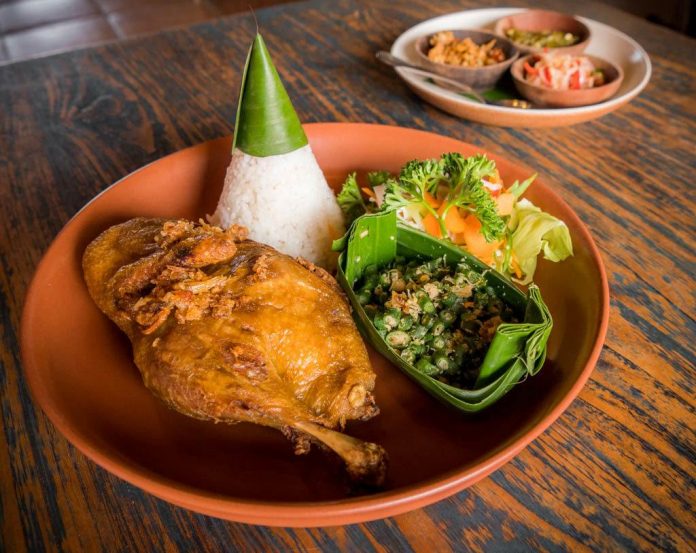Are you a foodie? If so, trying local cuisines must be on top of your to do list whenever you’re visiting a foreign country. If you don’t consider yourself a foodie and refuse to try local food, we’re sorry but it is a huge miss and believe us, you’ll regret it soon enough.
Indonesia is considered as one of the richest in terms of local foods that it might be overwhelming for tourists to pick ones they’d like to try. Local street food is especially tricky because there is A LOT of them. Thus, here’s our list of 9 delicious local street food you’d want to put on your to-eat list.
SATAYThis dish of seasoned, skewered, and grilled meat, served with a sauce might be the most familiar on this list. Although it’s originally from Indonesia, satay is also popular in Malaysia, Singapore, and Thailand. However, each region has different style of satay—even among Indonesia regions. Sate Padang (satay from Padang region) has different style from Madura. Different sauce, different way of grilling. Likewise, Bali has its own style of satay called Sate Lilit. What’s distinctive about Sate Lilit compared to the other satay is the addition of shredded coconut and coconut milk as its main ingredients for the minced meat. The meat options itself is ranging from pork, fish, chicken, beef, and even turtle. Yes, turtle.
NASI CAMPURNasi campur refers to Indonesian dish of a scoop of white rice accompanied by small portions of a number of other dishes, which includes meats, vegetables, peanuts, egg, and krupuk (crackers). Just like satay, nasi campur differs depending on the origin. What’s unique about Balinese nasi campur is its servings of traditional dishes like Ayam Betutu, Sate Lilit, and sambal matah. We recommend Nasi Campur Men Weti in Sanur, or Nasi Campur Ibu Mangku Kedewatan for you to try. RUJAKThe easiest way to explain what Rujak is, think of salad—but with way different style. Made of fruits and vegetables, Rujak (or Rojak) is a famous traditional dish from Southeast Asia. Here in Bali, there are two types of rujak you won’t find anywhere else; rujak pindang and rujak bulung. Rujak pindang is pretty similar with the other rujak; only with fish broth as its sauce. Whereas rujak bulung is something entirely different. It’s not made of fruits or the usual vegetables—it’s made of seaweed. Yes, seaweed. Its delectably flavorful taste plus affordable price makes it one of the top favorite dishes among Balinese people.
BAKSOOf course, bakso is a must on this list. This Indonesian meatball is the ultimate go-to street food in the country—just ask anyone. You might think it’s just another meatball like the one you’ve tried in Thailand or anywhere else in the world, but it’s not. Indonesian meatball—especially the street vendor kind—is different. The soup is different, the meatball itself is different, the noodle is different. Trust us, once you’ve tried bakso, one bowl might not be enough. SWEET CORNGoing to any mainstream beaches and you’ll see a strip of grilled sweet corn vendor not far from the shoreline. Each of them will try to compete for your attention, shouting ‘jagung bakar’—but probably the smell alone is enough for you to turn your head. If all this time you kept passing by and ignore those callings, give it a try. Those buttery grilled sweet corn will be the perfect companion for your sun gazing during sunset. TERANG BULANTerang Bulan, or sometimes called martabak manis, is a dessert common in Southeast Asia. It’s a close relative to pancake, only fuller and more buttery. It’s sprinkled with fillings before the pancake is folded (hence the name; “turnover pancake”). The standard ones will have peanut, chocolate sprinkle, cheddar, or sweetcorn. Nowadays, Terang Bulan has modern twist to it. Don’t be surprised if you see Toblerone, cream cheese, red velvet, or green tea on the menu. BABI GULINGBabi guling, or suckling pig, without a doubt, is one of Bali’s most famed dishes—if not the most. Best chance you already have it on your to-do list to try this classic dish of pig stuffed and infused with a wide range of spices typically involving turmeric, black pepper, lemongrass, coriander seeds, garlic, salam leaves, kencur, ginger, et cetera. Ibu Oka in Ubud might be the number one most famed spot on the island to grab a plate of Babi Guling, but there are plenty of others that are worth trying as well. Namely Pak Malen in Seminyak or Babi Guling Chandra in Denpasar.
NASI JINGGONasi Jinggo is Bali’s signature dish that you could find literally everywhere—every block, every market, every neighborhood, everywhere. It’s usually consists of white rice, egg, fried noodles, a little bit of shredded chicken, and homemade sambal served in rather very small portion wrapped in banana leaf. Nasi Jinggo is a good pick for quick breakfast. But if you’re not full enough with just one portion, another two or three won’t make you broke—it’s only about IDR 5,000 – IDR 10,000 per portion.
JAJA BALIThere’s nothing more mouthwatering than to see a plate of colorful assorted Balinese traditional cake sprinkled with shredded coconut, glistened with sugar. Pisang Rai, Laklak, Bubur Injin, Kelepon, Cerorot are only few of over sixty different kinds, shapes, and colors of Balinese rice cakes sold at any traditional market or warung run by locals. Next time you’re having a teatime (or coffee time), skip the macarons and opt for these authentic Balinese desserts instead.


























